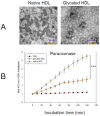Native High-Density Lipoproteins (HDL) with Higher Paraoxonase Exerts a Potent Antiviral Effect against SARS-CoV-2 (COVID-19), While Glycated HDL Lost the Antiviral Activity
- PMID: 33535459
- PMCID: PMC7912765
- DOI: 10.3390/antiox10020209
Native High-Density Lipoproteins (HDL) with Higher Paraoxonase Exerts a Potent Antiviral Effect against SARS-CoV-2 (COVID-19), While Glycated HDL Lost the Antiviral Activity
Abstract
Human high-density lipoproteins (HDL) show a broad spectrum of antiviral activity in terms of anti-infection. Although many reports have pointed out a correlation between a lower serum HDL-C and a higher risk of COVID-19 infection and progression, the in vitro antiviral activity of HDL against SARS-CoV-2 has not been reported. HDL functionality, such as antioxidant and anti-infection, can be impaired by oxidation and glycation and a change to pro-inflammatory properties. This study compared the antiviral activity of native HDL with glycated HDL via fructosylation and native low-density lipoproteins (LDL). After 72 h of fructosylation, glycated HDL showed a typical multimerized protein pattern with an elevation of yellowish fluorescence. Glycated HDL showed a smaller particle size with an ambiguous shape and a loss of paraoxonase activity up to 51% compared to native HDL. The phagocytosis of acetylated LDL was accelerated 1.3-fold by glycated HDL than native HDL. Native HDL showed 1.7 times higher cell viability and 3.6 times higher cytopathic effect (CPE) inhibition activity against SARS-CoV-2 than that of glycated HDL under 60 μg/mL (approximately final 2.2 μM) in a Vero E6 cell. Native HDL showed EC50 = 52.1 ± 1.1 μg/mL (approximately final 1.8 μM) for the CPE and CC50 = 79.4 ± 1.5 μg/mL (around 2.8 μM). The selective index (SI) of native HDL was calculated to be 1.52. In conclusion, native HDL shows potent antiviral activity against SARS-CoV-2 without cytotoxicity, while the glycation of HDL impairs its antiviral activity. These results may explain why patients with diabetes mellitus or hypertension are more sensitive to a COVID-19 infection and have a higher risk of mortality.
Keywords: COVID-19; SARS-CoV-2; glycation; high-density lipoproteins (HDL); low-density lipoproteins; paraoxonase.
Conflict of interest statement
The authors declare no conflict of interest.
Figures





References
-
- Dreux M., Dao Thi V.L., Fresquet J., Guérin M., Julia Z., Verney G., Durantel D., Zoulim F., Lavillette D., Cosset F.-L., et al. Receptor complementation and mutagenesis reveal SR-BI as an essential HCV entry factor and functionally imply its intra- and extra-cellular domains. PLoS Pathog. 2009;5:e1000310. doi: 10.1371/journal.ppat.1000310. - DOI - PMC - PubMed
LinkOut - more resources
Full Text Sources
Other Literature Sources
Research Materials
Miscellaneous

